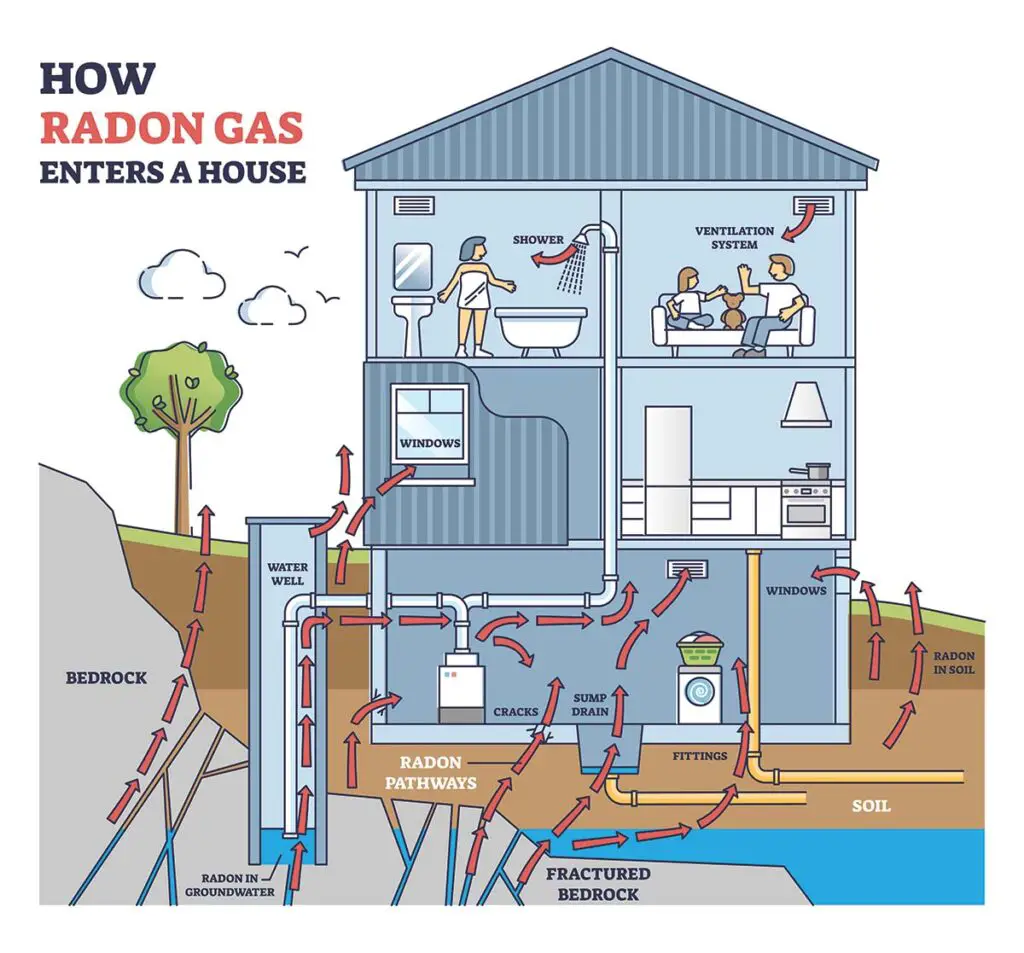Buying a house with radon mitigation systems can raise important questions. Radon is a naturally occurring radioactive gas that can build up to dangerous levels inside homes, posing health risks over time.
If you’re considering buying a house with a radon mitigation system it is crucial to test and verify the effectiveness of the radon mitigation system. Try to obtain documentation of the system’s installation and maintenance or testing records. Consult with a professional radon inspector to further assure the system’s reliability.
A mitigation system indicates that the property has high radon issues, but it also shows that steps have been taken to address the problem. Understanding the implications of radon, its health risks, and the functionality of mitigation systems is crucial in making an informed decision.
Buying a home with an existing radon mitigation system suggests that radon levels have likely been assessed and addressed. Yet, it remains essential for you to ascertain the current radon levels before proceeding.
Professional testing and inspection of the system ensure that it functions correctly and effectively and reduces radon to safe levels. While the presence of a system can initially be concerning, it can ultimately provide peace of mind, knowing that the home is protected against radon exposure.

Understanding Radon and Its Risks
Radon is a radioactive gas you cannot see, taste, or smell. It forms from the natural decay of uranium and thorium found in nearly all soils, and it typically moves up through the ground to the air above and into your home through cracks and other holes in the foundation.
Your home can trap radon inside, where it can build up. Any home may have a radon problem – new and old homes, well-sealed and drafty homes, and homes with or without basements.
The Environmental Protection Agency (EPA) advises that the radon concentration in indoor air is measured in picocuries per liter (pCi/L) of air and that levels of 4 pCi/L or higher require action.
Radon exposure is the second leading cause of lung cancer in the United States, with risks being higher in smokers compared to non-smokers. However, even non-smokers can face significant health risks if they live in environments with high prolonged radon exposure.
| Radon Level (pCi/L) | Risk for Non-smokers | Risk for Smokers |
|---|---|---|
| 4.0 | Moderate | High |
It’s essential to test the indoor air of any home you’re considering buying for radon; this is the only way to know your exposure level. The good news is if a home has a high radon level, procedures such as a radon mitigation system can reduce it to a safer level.
This system usually consists of a vent pipe system and a fan, which pulls radon from beneath the house and vents it to the outside, lowering the radon levels inside your home.
It’s not just about whether a house has a mitigation system but also about ensuring that the system effectively reduces radon levels to an acceptable level for your health and safety. Regular testing and maintenance of the system are critical to ensure ongoing protection from radon health risks.

Radon Mitigation Systems Explained
Understanding the components and functioning of a radon mitigation system is crucial if you’re considering a house equipped with one. The process involves specialized equipment and techniques to reduce radon levels in your home, thereby improving indoor air quality and safety.
Fundamentals of Radon Mitigation
Radon mitigation decreases radon gas concentrations in a building’s indoor air. The primary goal is to intercept radon before it enters your home, typically through suction that draws radon from beneath the foundation and vents it outside.
Special sealing of cracks and openings in the foundation and walls is also essential to limit the flow of radon into living spaces.
Types of Radon Mitigation Systems
Sub-slab Depressurization Systems: These systems, often considered the most effective radon mitigation method, involve installing suction pipes under the foundation slab connected to a fan that vents radon-laden air outside.
Drain-Tile Suction Systems: Utilizing existing perforated pipes or drain tiles around the foundation, this system applies suction to these areas, mitigating radon that enters these pathways.
Crawl Space Systems: For homes with crawl spaces, methods include covering the earth with a high-density plastic sheet and using a fan to draw radon gas from below the sheet and exhaust it outdoors.
HVAC Systems: While not explicitly designed for radon reduction, sealing and pressurization features of HVAC systems can influence indoor radon levels and may be considered supplemental to other radon mitigation strategies.
Factors Affecting Mitigation System Performance
To ensure the optimal performance of a radon mitigation system, consider the following:
Installation Quality: The integrity of the system’s installation, including proper sealing and placement of pipes and fans, is fundamental to its effectiveness.
Home Structure: The type of foundation—whether slab, basement, or crawl spaces—significantly impacts the mitigation approach and its success.
Soil Characteristics: Variations in soil composition and permeability beneath your home affect the radon gas movement and the system’s ability to reduce levels.
System Maintenance: Regular checks of the fan, monitoring systems, and seals are vital to maintain the reduction in radon levels.
Before buying a house with a mitigation system, it’s worth having it evaluated by a qualified professional to assess its effectiveness and ensure your long-term safety.

Assessing Radon Levels in the Home
When considering the purchase of a house with a radon mitigation system, it is crucial to assess the radon levels. This process will help you understand the effectiveness of the system in place and the potential risk associated with radon exposure in your future home.
Importance of Radon Testing
Testing for radon is the only way to quantify the concentration in your home, which is measured in picocuries per liter (pCi/L). It is important to use EPA-approved test kits or hire a qualified home inspector to conduct radon testing during the home inspection. Keep in mind that:
- The EPA recommends taking action if radon levels are 4 pCi/L or higher.
- A radon mitigation system should lower radon levels to a safer range, ideally below 2 pCi/L.
Understanding Radon Test Results
Once a radon test is completed, understanding the results is critical to evaluating your risk. Radon levels fluctuate, so a short-term test might not capture the full picture. Consider the following:
Results between 2 pCi/L and 4 pCi/L often suggest a potential for improvement, possibly indicating the need for system optimization.
Low radon levels below 2 pCi/L indicate that the mitigation system effectively reduces exposure risks.
High radon levels above 4 pCi/L demand immediate attention and mitigation system servicing or upgrade.
Using a long-term radon detector can provide an average over a period of time and offer a more accurate assessment of the radon levels in your home.
Health Concerns and Radon Exposure
Radon is a colorless, odorless gas that is a significant health risk, particularly as it relates to lung cancer. The Environmental Protection Agency (EPA) identifies radon exposure as the second leading cause of lung cancer in the United States, just behind smoking.
If you’re considering a home with a radon mitigation system, understanding the potential health concerns associated with radon exposure is critical.
Lung Cancer Risks
| Group | Risk of Lung Cancer |
|---|---|
| Smokers | High |
| Non-Smokers | Lower |
| Radon Exposure | Elevated |
For smokers, the risk of developing lung cancer is compounded when combined with high indoor radon levels.
Non-smokers have a lower risk, but the danger still exists and increases with the amount of radon they are exposed to over time.
Safe Radon Levels
The EPA recommends reducing radon in homes with radon levels at or above the action level of 4 picocuries per liter (pCi/L) of air.
A radon mitigation system is designed to decrease radon levels, often bringing them below the EPA action guideline, thereby reducing exposure and associated health risks.
When considering a home with an existing radon mitigation system, it is important to ensure it functions properly. Regular testing can confirm that radon levels remain within safe limits.
Buying a house with an effective radon mitigation system can be wise, as it addresses this environmental hazard and helps protect you and your family’s health.
Buying a Home With a Radon Mitigation System
When considering a home with an existing radon mitigation system, it’s crucial to assess its effectiveness, understand the disclosure process, and plan for ongoing maintenance.
Evaluating the Existing Mitigation System
Before proceeding with the purchase, enlist a licensed professional to inspect the radon mitigation system. Ensure it meets the current standards and is functioning correctly.
This home inspection is a critical step in the process, as it will give you confidence that the system is adequate and the indoor radon levels are within safe limits. Remember to ask for any available documentation or maintenance records.
Negotiations and Mitigation System Disclosure
Your real estate agent is a valuable resource during negotiations. If the existing system requires upgrades or repairs, you can often negotiate these costs with the seller before finalizing the purchase contract.
Be sure to review the radon disclosure form carefully; it should detail the system’s history and any known issues, a requirement that helps protect both potential buyers and sellers.
Long-Term Maintenance and Monitoring
A radon mitigation system is not a set-and-forget solution. After buying the home, you must monitor radon levels regularly to ensure continued safety.
Ongoing maintenance by a licensed professional or radon mitigation contractor may be necessary to keep the system performing optimally. This vigilance not only provides a healthy living environment but may also positively impact the resale value of your home.
Does Radon Reduce the Value of a Home?
The presence of radon in a home does not necessarily reduce its value. If a home has a properly installed radon mitigation system, it may be viewed as an improvement to the home and can be beneficial for maintaining or even increasing its value.
High radon levels can deter potential buyers and lead to delays or difficulties in selling a home, but professional radon mitigation can often reduce radon levels, making the home more desirable.
While radon is a known carcinogen, and its presence can be a concern for potential buyers, the impact on home value depends on whether the issue is properly addressed and mitigated.
Legal Considerations and Disclosure
When considering the purchase of a home with a radon mitigation system, it’s crucial to understand the legal aspects and the importance of full disclosure.
Radon is recognized by the Environmental Protection Agency (EPA) as a health hazard, and a mitigation system indicates that radon levels may have been a concern in the past.
- Sellers: They must disclose known hazards, including radon. Each state has specific requirements and disclosure forms. Make sure you receive and review this documentation.
- Real Estate Agent: Your agent should help you understand disclosure requirements and can assist in obtaining radon test results, if available.
- Mortgage Lender: Some lenders may require radon testing or mitigation as a loan condition, especially if high levels are common in the area.
As a homebuyer, it’s in your interest to verify the professionalism of the mitigation system installation. Ensure that a licensed professional performs the work and that documentation supports the system’s effectiveness.
Consult your state’s EPA guidelines for local information on radon levels and mitigation requirements.
Homeowners insurance does not cover radon mitigation. There are instances where the seller might cover the cost of mitigation, though it’s common for the expenses to be shared or for the buyer to cover the full cost. The price for installing radon mitigation systems ranges between $1,000 and $2,500.
Remember, while radon mitigation systems are not necessarily a deal breaker, they signify the need for due diligence. Protect yourself legally and financially by obtaining all relevant information before purchasing your new home.
Post-Purchase Radon Mitigation and Management
After purchasing a home with a radon mitigation system, your key responsibility is ensuring the system functions properly to maintain safe radon levels. Radon, odorless and undetectable without specialized equipment, can pose health risks if not effectively controlled.
Regular Maintenance:
- Visual Inspections: Regularly check the system’s components, such as the fan and vent pipe, for any signs of damage.
- Monitoring: You should continuously monitor radon levels, ensuring they remain below the EPA recommended action level of 4 pCi/L.
Professional Assessment:
- Annual Check-ups: It’s advisable to have a licensed professional conduct an annual review of the system to certify its efficiency.
- Professional Advice: A radon mitigation contractor can guide upgrades if the existing system doesn’t align with current EPA guidelines.
System Compatibility:
- HVAC Interference: Ensure your HVAC system does not interfere with the radon unit’s operation, as air currents can affect radon dispersion.
Know Your System:
- Types of Systems: Understand whether your system is a sub-slab depressurization, a sump pit system, or another type.
- Operation: Familiarize yourself with how your system operates to detect performance issues better.
You contribute to your health and environmental protection by actively managing your radon mitigation system. These steps ensure your living space remains a safe haven from radon exposure.
Additional Resources for Homeowners
When considering the purchase of a home with a radon mitigation system, you should be well-informed about radon, its risks, and the effectiveness of mitigation systems. Below are resources that can aid in your understanding and decision-making process.
Environmental Protection Agency (EPA)
The EPA’s radon page offers comprehensive information on radon, including health risks, testing, and mitigation. Using their resources can help you understand the steps taken in the existing mitigation system in the home you are considering.
Consulting a Radon Specialist
Seek advice from a qualified radon specialist who can assess the existing mitigation system’s condition and efficiency. Ensure they are certified and have the necessary credentials.
DIY Resources
While professional assessment is recommended, follow reliable guidelines if you are inclined towards DIY. The EPA provides guidance on DIY testing, which could be a first step toward assessing radon levels before or after the purchase.
By utilizing these resources, you will be better positioned to make an informed decision about the home you are interested in. Remember, ensuring your future home is safe from radon is a valuable investment in your and your family’s health.
Frequently Asked Questions
How effective are radon mitigation systems in reducing radon levels?
Radon mitigation systems are designed to reduce radon levels in the home. The right system can reduce radon below the EPA action level of 4 picocuries per liter (pCi/L).
What is the impact of a radon mitigation system on home resale value?
A radon mitigation system can positively impact the resale value of a home. Buyers often appreciate the safety measures taken to ensure the home is radon-free.
Are homes with radon mitigation systems considered safe to live in?
Homes with radon mitigation systems that are properly installed and maintained are generally considered safe to live in. Verifying that the system effectively reduces radon levels to within safe limits is essential.
What are the indications that a home requires a radon mitigation system?
Indications that a home may require a radon mitigation system include radon test results above the EPA action level of 4 pCi/L. Potential buyers should also look for visible signs of a system or ask for documentation.
Can high radon levels be a critical factor in the home buying decision?
High radon levels can be critical, and remediation is often required, especially if levels exceed the recommended action threshold of 4 pCi/L.
Does the installation of a radon mitigation system necessitate ongoing maintenance?
Ongoing maintenance is necessary to ensure a radon mitigation system operates correctly. This includes regular system inspections and possibly post-mitigation radon testing to confirm that radon levels remain low.
Is radon a dealbreaker?
No, radon is not a dealbreaker. There are millions of homes affected by radon gas. While high radon gas is dangerous, radon testing, monitoring, and mitigation systems effectively detect and control radon gas.
Should you buy a house with high levels of radon?
It is recommended to mitigate high levels of radon before purchasing a house. Testing, monitoring, and installing a radon mitigation system can protect you and your family from dangerous radon gas exposure.







